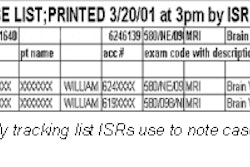SCOTTSDALE, AZ -- The losses associated with healthcare fraud hover near $54 billion annually in the U.S. At the same time, successful criminal prosecutions and civil actions recover only about $2 billion a year for the federal government and private programs.
From the government’s perspective, there’s a lot of money in healthcare that needs to be recovered. As a result, the U.S. Department of Justice (DOJ) and the Office of the Inspector General (OIG) of the Department of Health and Human Services (HHS) have made it a top priority to track down fraud and abuse. Congress has committed over $1 billion to fund more FBI agents and prosecutors through fiscal year 2003.
"As radiology gets a bigger slice of the healthcare pie, it will come under greater scrutiny by the FBI for fraud," said Marc Garber, an attorney at Atlanta-based Alston and Bird, during his talk Tuesday at the Radiology Business Management Association's 2001 meeting.
In a presentation aimed at preparing radiology managers for an OIG fraud and abuse investigation, Garber offered his years of experience as both a federal prosecutor with the DOJ and then as a client advocate.
Business mangers, bills, and blame
"Business managers have the greatest stake in compliance to fraud and abuse regulations, because they are the ones to whom all fingers will point if there’s ever an investigation," cautioned Garber.
He recommended that the facility hire an attorney knowledgeable in healthcare law to draft a compliance program and policy. The program must be designed to prevent and detect fraud and abuse. "Providers who fail to implement a compliance program do so at their peril," he said.
The penalties for fraud and abuse are prohibitively expensive. Each instance can cost the offending facility up to three times the original amount billed, plus a fine of up to $10,000 per infraction. Also, prosecutors can search back as far as seven years through an institution’s records to investigate fraud and abuse. The potential liability is enormous for even a small- or medium-sized facility, he said.
Critical compliance
Garber espoused four key elements that belong in any compliance program:
- A comprehensive policy statement detailing the goals of the program.
- An effective mechanism for educating employees about the applicable laws and regulations.
- A way to monitoring employees’ compliance with these rules.
- A meaningful system for reporting potential problems.
It is crucial that owners of the facility support the compliance program. Garber suggested that managers take the time to outline the economic liability of fraud and abuse to executive management.
"It probably won’t hurt to mention the potential of federal jail time for some infractions," he added.
Managers should focus most of their attention on the billing practices of the institution, for this is where prosecutors will look first. Check for the amount of time each current procedure terminology (CPT) code is used in reimbursement billing, Garber advised.
Next, informally poll associates in the same region as to their use of the same or similar codes. This will provide the facility manager with a rough peer-group analysis, a critical tool that prosecutors use to sniff out potential fraud and abuse. If your group is using a particular code more often than your regional peers, an outside audit may be in order to assess potential liability.
Don’t expect Mulder and Scully
"There are two modes that managers have to master when it comes to fraud and abuse: crisis avoidance and crisis management. Crisis avoidance is putting together and following a compliance program. Crisis management is controlling the flow of information during a crisis," Garber said. "And any investigation is a crisis."
If and when the FBI shows up with a search warrant, it may bring along a whole host of counterpart agents: representatives from the OIG, the U.S. Postal Service (wire fraud), the Internal Revenue Service (tax fraud), and the Immigration and Naturalization Service (to check residency rights). This could give your institution a 2-to-1 federal-agent-to-employee ratio, he quipped. And the search warrant is always timed to take place during business hours for maximum impact.
A business manager should make sure staff members know their rights before granting an interview with government agents, including the following:
- There is no obligation to answer any questions.
- An employee cannot be arrested for declining to answer questions.
- Politely, but firmly, refuse to answer any questions before speaking with counsel.
- A person has the right to have an attorney present while being questioned.
An experienced attorney should be called immediately upon learning of a government investigation. The business manager, or designee, should have access to a cell phone to place the call, as investigators may shut down land-based phone lines, Garber said. It’s best to cooperate fully and completely with the facility’s attorney.
Garber wrapped up his talk with a warning from a high-ranking justice department official: "Any healthcare entity that does not have a compliance plan is institutionally nuts," he said.
By Jonathan S. BatchelorAuntMinnie.com staff writer
June 6, 2001
Related Reading
OIG audits are scary but survivable, September 22, 2000
U.S. fraud and abuse rules create a minefield for imaging vendors, August 31, 2000
Public Affairs Update: Identifying "Excluded Individuals", January 1, 2000
Click here to post your comments about this story. Please include the headline of the article in your message.
Copyright © 2001 AuntMinnie.com



















